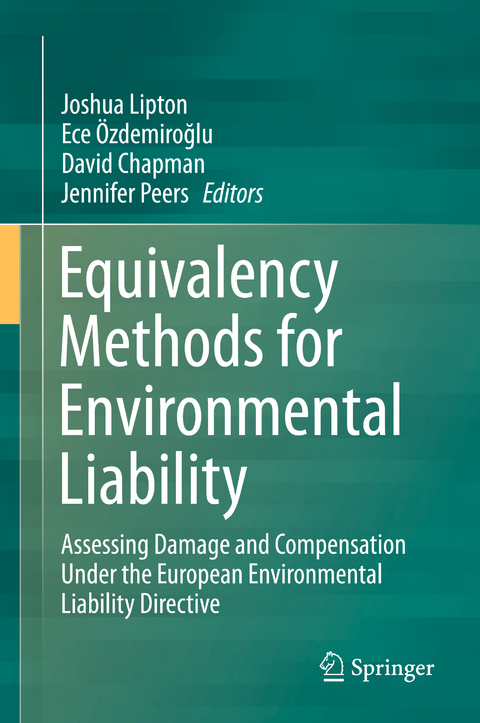
Equivalency Methods for Environmental Liability
Springer (Verlag)
978-90-481-9811-5 (ISBN)
Joshua Lipton is an internationally recognized expert in the determination, quantification, and restoration of adverse impacts to natural resources. For more than 25 years, Josh has been a leader in the development and application of technical methods, guidance, and regulatory and policy approaches. In the US, Josh has served as a lead scientist and technical director on many of the prominent natural resource damage assessments undertaken by federal, state and tribal authorities. He has assessed the effects of inorganic and organic pollutants on terrestrial, marine, and freshwater biological resources and habitats; surface and groundwater resources; soils; air; and human and ecological services. In the EU, Josh served as lead scientist and author of the technical toolkit for assessing and quantifying natural resource damages pursuant to the ELD and provided technical training. Josh’s technical expertise is in aquatic, marine, and terrestrial ecotoxicology; ecological assessments; chemical characterization, fate, and transport; applied ecology and population biology; and uncertainty analysis. Ece Ozdemiroglu is an environmental economist. She started her career in 1992 by founding eftec. She specializes in interpreting economic value evidence for natural capital, ecosystem services, cultural heritage, value of information and education. Her adventure with ELD started with a review of the economic concept of value, damage and benefit of remediation; use of cost benefit analysis and experience of the Natural Resource Damage Assessment experience in the US. Between 2006 and 2008, she coordinated the DG Research & Innovation funded project on the use of equivalency methods for implementing the ELD. Since then she led the writing of the EC brochure and factsheet and training materials for the ELD and organized / delivered training across the EU. Ece is a member of the UK Climate Change Committee – Adaptation Sub Committee; the Economics Lead for theValuing Nature Programme and an associate editor of the Journal of Environmental Economics and Policy. David Chapman is the Human Dimensions Science Program Manager at the US Forest Service Rocky Mountain Research Station, where he oversees a team of 30 researchers investigating multiple aspects of human interactions with the environment. Prior to joining the Station in September 2015, David spent 13 years at Stratus Consulting in Boulder CO, where he led the natural resource economics group. Before that, David spent 10 years at NOAA’s Damage Assessment Center where he was the Pacific Coast Branch manager and senior economist and, over his career, he has led over 25 litigation studies for state, federal, and tribal clients. His most recent assessment work was leading the human use and total value assessment teams for the Deepwater Horizon Oil Spill on behalf of federal and state trustees. He is co-author of the EC guidance document on the use of equivalency methods in the ELD and has led natural resource damage assessment training sessions throughout the United States and in more than 14 EU Countries. Jennifer Peers is an environmental scientist who has conducted numerous evaluations of natural resource damages and equivalency analyses to compensate for harm to the environment. Her expertise includes environmental impacts, water quality, ecological services, and remediation planning. Jennifer has provided technical training on equivalency analyses in the US and on the ELD to multiple European member states.
PART I –INTRODUCTION TO RESOURCE EQUIVALENCY METHODS TO ASSESS AND SCALE ENVIRONMENTAL DAMAGE IN THE EU.- 1.The Environmental Liability Directive: Legal Background and Requirements.- 2. Resource Equivalency Methods in the European Union: A ‘Toolkit’ for Calculating Environmental Liability.- PART II –RESOURCE EQUIVALENCY METHODS TO ASSESS AND SCALE ENVIRONMENTAL DAMAGE IN THE EU.- 3. Step 1: Performing an Initial Evaluation.- 4. Step 2: Determining and Quantifying Environmental Damage.- 5. Step 3: Determining and Quantifying Remediation Benefits.- 6. Step 4: Scaling Complementary and Compensatory Remediation.- Step 5: Monitoring and Reporting.- 8. Valuation chapter.- PART III – CASE STUDIES.- 10. Ex-Ante Analysis of a Hypothetical International Road Construction Project in Poland.- 11.Severe Wildfire in a Mediterranean Forest.- 12.Water Abstraction from the River Itchen, Hampshire, United Kingdom.- 13. Hypothetical Resource Equivalency Analysis: Damage to Alpine Brown Trout
| Zusatzinfo | 43 Illustrations, black and white; XX, 281 p. 43 illus. |
|---|---|
| Verlagsort | Dordrecht |
| Sprache | englisch |
| Maße | 155 x 235 mm |
| Themenwelt | Sachbuch/Ratgeber ► Natur / Technik ► Natur / Ökologie |
| Naturwissenschaften ► Biologie ► Ökologie / Naturschutz | |
| Naturwissenschaften ► Chemie | |
| Naturwissenschaften ► Geowissenschaften ► Geografie / Kartografie | |
| Recht / Steuern ► EU / Internationales Recht | |
| Recht / Steuern ► Öffentliches Recht ► Umweltrecht | |
| Technik ► Umwelttechnik / Biotechnologie | |
| Wirtschaft | |
| ISBN-10 | 90-481-9811-9 / 9048198119 |
| ISBN-13 | 978-90-481-9811-5 / 9789048198115 |
| Zustand | Neuware |
| Haben Sie eine Frage zum Produkt? |
aus dem Bereich


